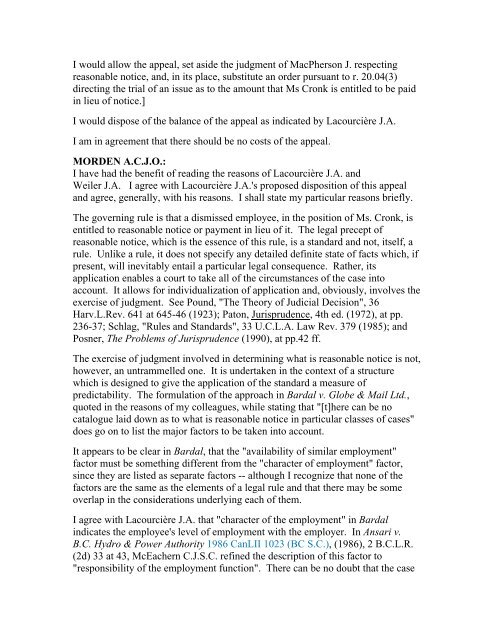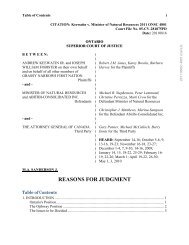Cronk v. Canadian General Insurance Co., 1995 CanLII 814 (ON CA)
Cronk v. Canadian General Insurance Co., 1995 CanLII 814 (ON CA)
Cronk v. Canadian General Insurance Co., 1995 CanLII 814 (ON CA)
Create successful ePaper yourself
Turn your PDF publications into a flip-book with our unique Google optimized e-Paper software.
I would allow the appeal, set aside the judgment of MacPherson J. respecting<br />
reasonable notice, and, in its place, substitute an order pursuant to r. 20.04(3)<br />
directing the trial of an issue as to the amount that Ms <strong>Cronk</strong> is entitled to be paid<br />
in lieu of notice.]<br />
I would dispose of the balance of the appeal as indicated by Lacourcière J.A.<br />
I am in agreement that there should be no costs of the appeal.<br />
MORDEN A.C.J.O.:<br />
I have had the benefit of reading the reasons of Lacourcière J.A. and<br />
Weiler J.A. I agree with Lacourcière J.A.'s proposed disposition of this appeal<br />
and agree, generally, with his reasons. I shall state my particular reasons briefly.<br />
The governing rule is that a dismissed employee, in the position of Ms. <strong>Cronk</strong>, is<br />
entitled to reasonable notice or payment in lieu of it. The legal precept of<br />
reasonable notice, which is the essence of this rule, is a standard and not, itself, a<br />
rule. Unlike a rule, it does not specify any detailed definite state of facts which, if<br />
present, will inevitably entail a particular legal consequence. Rather, its<br />
application enables a court to take all of the circumstances of the case into<br />
account. It allows for individualization of application and, obviously, involves the<br />
exercise of judgment. See Pound, "The Theory of Judicial Decision", 36<br />
Harv.L.Rev. 641 at 645-46 (1923); Paton, Jurisprudence, 4th ed. (1972), at pp.<br />
236-37; Schlag, "Rules and Standards", 33 U.C.L.A. Law Rev. 379 (1985); and<br />
Posner, The Problems of Jurisprudence (1990), at pp.42 ff.<br />
The exercise of judgment involved in determining what is reasonable notice is not,<br />
however, an untrammelled one. It is undertaken in the context of a structure<br />
which is designed to give the application of the standard a measure of<br />
predictability. The formulation of the approach in Bardal v. Globe & Mail Ltd.,<br />
quoted in the reasons of my colleagues, while stating that "[t]here can be no<br />
catalogue laid down as to what is reasonable notice in particular classes of cases"<br />
does go on to list the major factors to be taken into account.<br />
It appears to be clear in Bardal, that the "availability of similar employment"<br />
factor must be something different from the "character of employment" factor,<br />
since they are listed as separate factors -- although I recognize that none of the<br />
factors are the same as the elements of a legal rule and that there may be some<br />
overlap in the considerations underlying each of them.<br />
I agree with Lacourcière J.A. that "character of the employment" in Bardal<br />
indicates the employee's level of employment with the employer. In Ansari v.<br />
B.C. Hydro & Power Authority 1986 <strong>CanLII</strong> 1023 (BC S.C.), (1986), 2 B.C.L.R.<br />
(2d) 33 at 43, McEachern C.J.S.C. refined the description of this factor to<br />
"responsibility of the employment function". There can be no doubt that the case
















